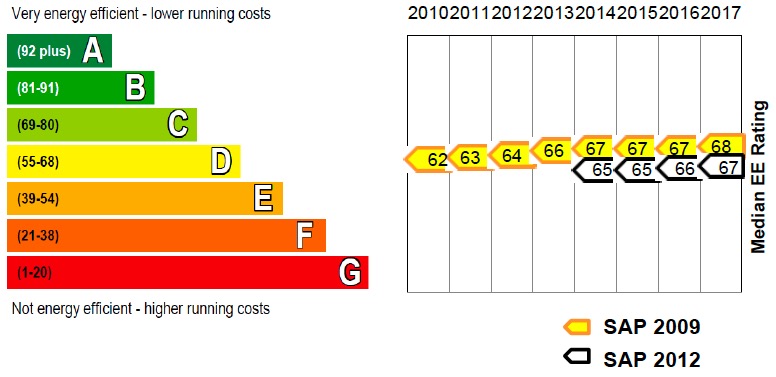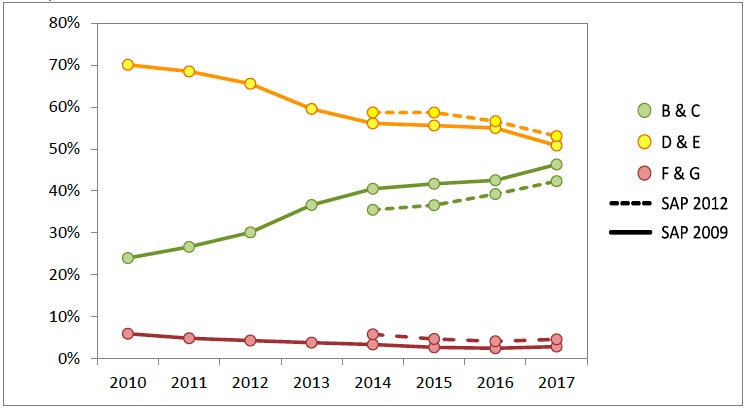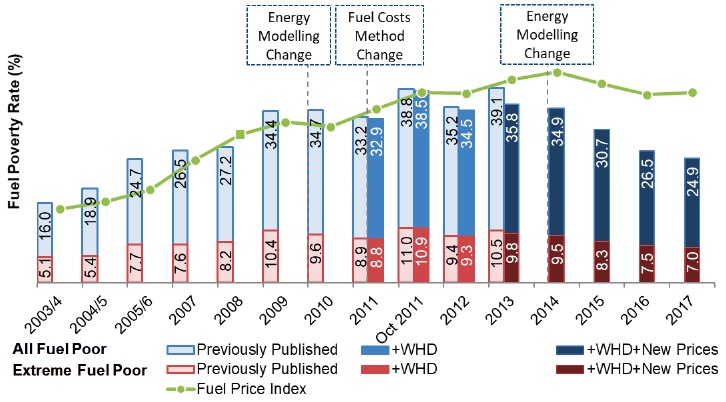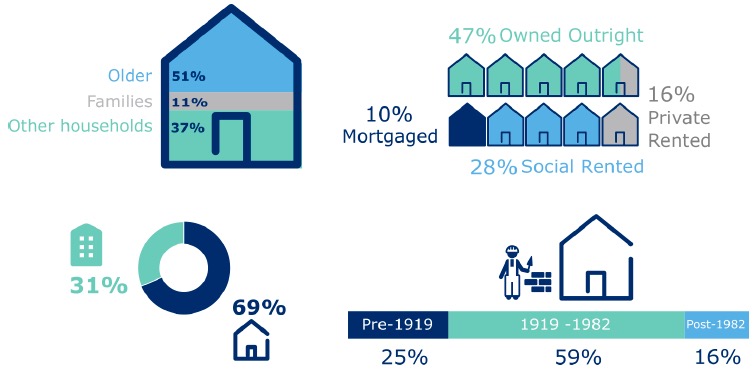Scottish house condition survey: 2017 key findings
Indicators from the 2017 survey, including updated fuel poverty rates, energy efficiency ratings, carbon emissions and Scottish Housing Quality Standard.
This document is part of a collection
Key Findings Summary
Energy Efficiency and Carbon Emissions
- In 2017, 42% of Scottish homes were rated as EPC band C or better and half had an energy efficiency rating of 67 or higher (SAP 2012). This is a significant increase from 39% in 2016 and continues the improving trend from 35% in 2014, the first year in which data based on SAP 2012 is available.
- In the last year, the share of properties built between 1945 to 1964 and post-1982, in band C or better, increased by 6 percentage points to 37% and by 5 percentage points to 74% respectively. In addition, the share of properties which are off the gas grid increased from 30% rated C or better to 36% while those using gas as their primary heating fuel increased from 44% to 47% and those in urban areas increased from 43% to 46%.
Median Energy Efficiency Rating Relative to EPC Band, SAP 2009 and SAP 2012, 2010 to 2017

- Using SAP 2009 continues to show improvement in the energy efficiency profile of housing. The share of the most energy efficient dwellings (rated C or better) increased from 24% in 2010 to 46% in 2017. In the same period, the proportion of properties in the lowest EPC bands (E, F or G) more than halved, reducing from 27% to 13%.
Proportion of Scottish Homes by Grouped EPC Band, SAP 2009 and SAP 2012, 2010-2017

- The share of homes with lofts insulated to 100 mm or more remained at 94% in 2017. This represents an increase of 12 percentage points on 2010 levels. 30% of lofts were insulated to a high standard of insulation (300 mm or more), a similar level to 2015 and 2016, following significant increases from 5% in 2010.
- Wall insulation measures continue to be delivered under energy efficiency programmes such as the Energy Company Obligation (ECO)[1] and the SHCS data suggests that this is having an impact on the share of dwellings with wall insulation although sample size limitations mean that the difference since 2016 is not statistically significant. Levels of wall insulation remained similar in the last year, with 60% of walls having insulation in 2017. However, there is a longer term trend of improvement with 18% of solid wall dwellings and 75% of cavity wall dwellings being insulated in 2017, representing an increase from 11% and 66% respectively in 2012.
- In 2017, 57% of gas and oil boilers meet the minimum efficiencies specified by current Building Standards, an increase of 5 percentage points from 2016.
- 32% of dwellings had an environmental impact rating in band C or better in 2017 (SAP 2012) an increase from 29% in 2016. The mean rating was 60 and the median was 63, both of which lie in band D.
- · Based on modelled energy use the average Scottish home is estimated to produce 7.0 tonnes of CO2 per year. Average modelled carbon emissions for all properties have decreased in the last year from 76 kg/m2 2016 to 74 kg/m2 in 2017.
Fuel Poverty and Heating Satisfaction
- In 2017, 24.9% of households (613,000) were estimated to be in fuel poverty, a similar level to 2016 (26.5% or 649,000 households). 7.0% (or 174,000 households) were living in extreme fuel poverty in 2017. This follows a period of annual decreases between 2014 and 2016 and is the lowest rate recorded by the survey since 2005/06.
Proportion of Households in Fuel Poverty and Extreme Fuel Poverty, 2003/4-2017

Note: Energy requirement underpinning fuel poverty estimate modelled on the following basis: 2003/4 – 2009: BREDEM – 12; 2010 – 2013: BREDEM 2012 v.1.0; from 2014 onwards: BREDEM 2012 v.1.1. + WHD indicates the inclusion of Warm Homes Discount, and + New Prices to the adjustment of fuel price sources; from 2016 a further improvement is included by assigning pre-payment metered fuel prices to the relevant households.
- There was no significant difference in the fuel poverty rate between 2016 and 2017. Increases in fuel prices in this period have been offset particularly by increases in household incomes as well as improvements in the energy efficiency of dwellings.
- Between 2016 and 2017 fuel poverty decreased in urban areas increasing the gap when compared to the rural areas. Households using gas as their primary heating fuel have continued to see improving fuel poverty rates in 2017. This is likely to be due, at least in part, to gas prices continuing to fall though not as steeply as in 2016. Consequently, fuel poverty rates fell in the last year for households living in urban areas, from 24% in 2016 to 21% in 2017.
- Those households using oil as their primary heating fuel saw the greatest increase in fuel poverty rates with 40% estimated to be in fuel poverty in 2017, up from 26% in 2016. This follows a 24% increase in liquid fuel prices between 2016 and 2017 although oil prices would have to increase by another 45% to reach their 2013 levels. Oil is more commonly used in rural areas than urban and therefore this has contributed to the fuel poverty rate in rural areas remaining at 43% in 2017 (not significantly different from the 37% recorded in 2016).
- On average the social and private sector have similar rates of fuel poverty at 24% and 27% respectively in 2017. This marks a change from 2016 where there was a significant difference between these sectors. Mortgaged households remain those with the lowest rates of fuel poverty (11%) while households who own their property outright have the highest rates (35%). Households in local authority housing saw an improvement in fuel poverty rates with 28% estimated to be in fuel poverty, compared to 36% in 2016.
Composition of Fuel Poor Households, 2017

- Over half of fuel poor households are older households while 11% are families with children and 37% are other households without children. The majority (57%) are owner occupiers (owned outright and mortgaged) and over two-thirds live in houses (69%).
- Over a third (37%) of fuel poor households have incomes above the poverty threshold, defined as £313 per week before housing costs for a couple without children. This is similar to 2016. Fuel poverty rates for households living above the income poverty threshold, were a similar level in 2016 (13%) and 2017 (12%). The rate for households below the income poverty threshold has also remained similar to 2016 levels at 70%.
- Fuel poor households are more likely to report difficulties staying warm in winter. 22% of them say that their heating keeps them warm in winter “only sometimes” (15%) or “never” (6%) compared to 18% of all other households. This pattern and overall rate is similar to 2016. 7% of fuel poor households report that they cannot afford to heat their home, higher than the 4% of non-fuel poor households.
- Overall, there has been no change in the past year in the share of all householders reporting that their heating only sometimes (14%) or never (4%) keeps them warm in winter.
- The extent to which home energy use is monitored by householders remains unchanged since last year with 54% stating they monitor their energy use “very” or “fairly closely”. However there has been an increase of 8 percentage points, to 18%, in households reporting that they own an energy monitoring device. Fuel poor households are no more likely to monitor their energy use than other households but they are less likely to own a monitoring device (14% compared to 20% for non-fuel poor households).
Housing Quality
- The level of disrepair was unchanged from last year, with 68% of all dwellings having some degree of disrepair, however minor it may be in 2017. Disrepair to critical elements stood at 50%, while 28% of dwellings had some instance of urgent disrepair, and 5% had some extensive disrepair. While these figures are not statistically different from 2016, there is still a longer-term trend of improvement.
- Levels of damp and condensation improved slightly compared to 2016. 91% of properties were free from any damp or condensation, up from 89%
- Levels of compliance with the tolerable standard in 2017 remained similar to 2016: 1% (or 24,000) of all dwellings fell below the Tolerable Standard. Longer term this represents an improvement of 3 percentage points since 2012.
- Across the stock as a whole, Scottish Housing Quality Standard (SHQS) compliance improved on 2016 levels. In 2017, 40% of Scottish homes failed to meet the SHQS, down from 45% in 2016.
- The SHQS failure rate in the social sector was 37%, not allowing for abeyances and exemptions. This has fallen from 60% in 2010. 26% of properties did not meet the Energy Efficient criterion.
- SHCS surveyors may not always be able to identify the presence of cavity wall insulation. The overall SHQS failure rate in the social sector would be 25% if it is assumed that all social dwellings have insulated cavity walls where this is technically feasible.
- The majority of dwellings falling below the SHQS failed on a single criterion: this accounts for more than 9 out of 10 failures in the social sector. For 8 out of 10 social homes which failed the SHQS this was due to falling short on a single one of the standard’s 55 elements.
- Overcrowding levels in Scotland remain unchanged: 3% of all households (66,000) were living in overcrowded accommodation in 2017.
There is a problem
Thanks for your feedback